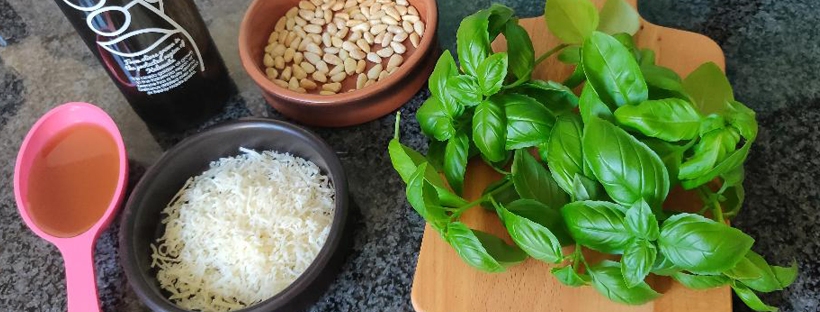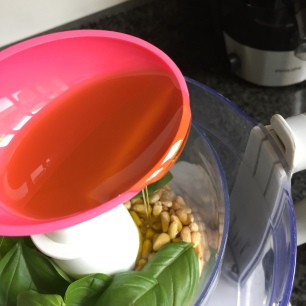Rob and I love to cook and, mostly, we manage to cook meals from scratch. Our boys can be fussy eaters but one meal they both love is pesto pasta: whole wheat fusilli with a dollop of pesto – until recently, we bought it as it was easier and we believed it was pretty healthy.
I read an article by Which? that changed my mind about shop-bought pesto. Reviewing standard pesto from seven supermarkets, they found all had added ingredients to bulk it out – among these were bamboo fibre, water, sugar and potato flakes. They often replaced traditional ingredients with cheaper alternatives: sunflower oil for olive oil; cashew nuts for pine nuts.
Reading this motivated me to find out how I could make my own pesto. I found a few recipes which I tweaked until I had a version I was happy with.
INGREDIENTS
These ingredients make roughly the same amount as a shop-bought jar of pesto.
30g grated Parmigiano-Reggiano*
30g toasted pine nuts
120ml extra virgin olive oil
Big (big!) bunch of fresh basil leaves (better value bought as a potted plant)
*In major supermarkets you won’t find “Parmesan” as this is often a generic term for Italian hard cheeses. For the genuine article, you need to look for “Parmigiano-Reggiano”.
METHOD
1. Add all your ingredients to a blender and whizz it all up until it’s the right consistency for you.
2. There is no step 2. You’re all done! 😉
The aroma is amazing – it’s fresh and smells of summer. I put a photo of my first jar on social media and most of the comments were about the colour: “It’s so green!”
In a tightly sealed container, your pesto should keep fresh in the fridge for around four days. However, if you’re like me, it will all be eaten before then! You could freeze it in an ice cube tray, although I don’t know how this will affect the taste, if at all.
VARIATIONS
You could experiment with the cheese grated or cut into chunks. The consistency was a lot smoother with grated cheese, which our boys prefer, but if you like a coarser texture, cut it into chunks or slices – this is more time efficient, too!
For an authentic Genovese pesto, you need Parmigiano-Reggiano and extra virgin olive oil. Of course, you can deviate from these – I won’t tell. 😉
HOW TO eat it
Pesto pasta is the obvious choice. I’ve found I need a lot less for a bowl of pasta compared to shop-bought, as there is much more flavour.
We’ve also used it with new potatoes for a fresh potato salad side dish, and it went down well with friends. (Shown below as shared on Instagram.) If you like fish you can spread a layer of pesto over a fillet, wrap loosely in foil and bake in the oven (works well with white fish or salmon). You could also spread it on a pizza base and top with chicken or vegetables. Stirred into cream cheese or crème frâiche it would make a fresh dip for breadsticks or crudités.
Anyone else feel hungry?
COST comparison
For a 190g jar of Sacla classic basil pesto, you would pay £2.50 (at time of writing).
For an equivalent amount of homemade pesto, the cost was £3.23. Not a lot more and it goes further as you use less per meal. Plus, you know that 100% of the ingredients are fresh and clean. No added salt, thickeners, bamboo(!) or any other rubbish. 😉
Perhaps best of all, our boys have taken a genuine interest in where their food comes from. They love the flavour of this fresh pesto and it’s so easy to make.
What’s not to love?

Bye for now!










The basil was beautiful this year, so we’ve stashed a lot in the freezer!
LikeLike
Does it freeze well? I’ve tried freezing fresh herbs before and they’ve turned a darker colour and flavour was lost. What am I doing wrong?!
LikeLike